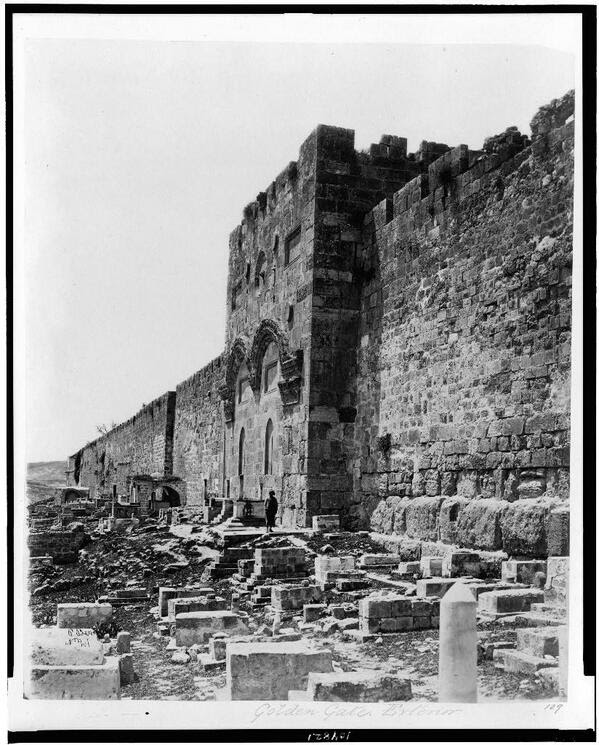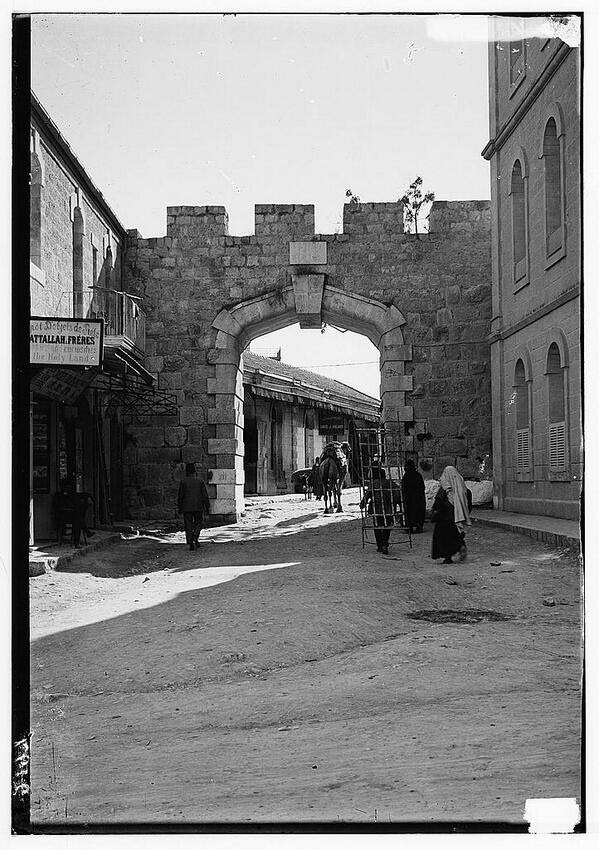Israel's History - a Picture a Day (Beta) |
Showing posts with label Dung Gate. Show all posts
Showing posts with label Dung Gate. Show all posts
Thursday, May 29, 2014
The Gates of Jerusalem's Old City -- In Honor of "Jerusalem Day"
Tuesday, November 26, 2013
Israel's History - a Picture a Day (Beta) - Walls & Gates of Jerusalem
Israel's History - a Picture a Day (Beta) |
The Chatham University Archives placed all 110 colored slides from the"Holy Land Lantern Slides"online, and in this posting we present a selection to focus on the collection's pictures of Jerusalem's walls and gates.
This Picture of Jaffa Gate has been featured in previous postings when we found it in other collections.
We also determined that the photo was taken prior to 1898 because of a glimpse of the moat wall on the right side of the picture. The wall was torn down and the moat filled in so that the Germany emperor's carriage could enter.
There are no pictures of the Zion, Dung and Herod Gates of the Old City. The "New Gate" of the Old City, an entrance built for access into the Christian Quarter, was constructed in 1889, after the photographs were taken.
The "lions" carved on both sides of the gate are actually panthers, the symbol of the Mamluk Sultan Baybars (1223-1277). The panthers were believed to have been part of a Mamluki structure and placed at the gate by Suleiman to commemorate the Ottoman victory over the Mamluks in 1517. View an earlier posting on Lions Gate here.
See our previous feature on
Sha'ar Harachamim and the graves
beneath it here.
|
Monday, June 18, 2012
Eight Gates of Jerusalem Today
Sites and Insights: Gates of Jerusalem - Jerusalem Post

Photo: Courtesy
By WAYNE STILES
06/18/2012 17:47
Photo: Courtesy
Wayne Stiles has never recovered from his travels in the Holy Land. Follow him on Twitter (@WayneStiles) or on his blog at www.waynestiles.com.
The walls and gates of Jerusalem have expanded and contracted over the centuries like the breathing of a living being.
The walls of the Old City of Jerusalem are such that we have to enter through the gates—just as people did for thousands of years.
Gates were more than passageways. They served as places for personal business andcivic affairs (see Ruth 4:1). Gates often took their names from the distant cities they faced, like Jaffa, Damascus, and Shechem.
The gates of Jerusalem today mostly date from the time when Suleiman the Magnificent rebuilt the walls around 1537. Moving counterclockwise around the wall:
Jaffa Gate

Because the Jaffa Gate also faces Hebron, where Abraham is buried, Arabs call the gate, Bab el-Khalil, “Gate of the Friend,” because of Isaiah 41:8. The gate offers easy access to the Citadel Museum and a walk on the ramparts. General Allenby memorably entered Jerusalem in 1917 through the Jaffa Gate.
Zion Gate

Immediately south of this gate sits modern “Mount Zion.” ItsArabic name, Bab Nabi Daud, “Gate of the Prophet David”—came about because David’s tomb supposedly rests on Mount Zion. A misnomer on all counts, biblical Zion (as well as David’s Tomb), rests east of its modern designation. The gate wears a pockmarked facade, voiceless scars from the fierce fighting for the Jewish Quarter in 1948.
Dung Gate

The unusual name stems from a gate that stood along the city’s south wall in the time of Nehemiah (Nehemiah 2:13). The Targum identifies the Dung Gate as the “Potsherd Gate” of Jeremiah 19:2. In antiquity, the city dump lay in the nearby Hinnom Valley, and the Potsherd Gate served as the exit by which the citizens took out the garbage.
Golden Gate

Bricked closed for more than 1,000 years, this gate is sometimes confused with the “Beautiful Gate” of the Second Temple (Acts 3:10). Muslim tradition holds that a conqueror or the Messiah will enter through this gate. Indeed, the Bible does predict the glory of the Lord will enter the Temple by means of “the eastern gate” (Ezekiel 43:4), but who knows if it refers to this one. Regardless, no bricked gate will deter the Messiah.
Stephen’s Gate

Christians have identified this gate with Stephen’s name in honor of his martyrdom outside the city (Acts 7:58-60). However, Byzantines placed his death outside a northern gate. Another name, “Lion’s Gate,” comes from the stone reliefs of two lions (or panthers or jaguars) that flank the gate.
Herod’s Gate

Sometimes called the “Gate of Flowers,” or Bab ez-Zahar, this gate took Herod’s name in the 16th or 17thcentury because pilgrims mistook a Mamluk house near the gate to be Herod Antipas’ palace. In this area the Crusaders penetrated the walls to capture the city in 1099.
Damascus Gate

A fine example of Ottomanarchitecture , this is the most beautiful of the gates of Jerusalem. Excavations below the gate reveal a triple-arched gateway that Hadrian built—the northern extent of the Cardo street from the second century. Outside the gate, an Arab market offers fresh fruit and vegetables. The Jews call it the “Shechem Gate,” and the Arabs refer to it as the "Gate of the Column.”
New Gate

The antiquity of the city walls is betrayed by the “New Gate,” opened in 1887 as a means of convenient northwest access to the Old City. I lodged for a week in the Christian Quarter years ago, grateful for the easy access the New Gate allowed to the city streets.
The Future Gates of Jerusalem
The 8 gates of Jerusalem have stood for centuries. But the Prophet Ezekiel predicted a day when the gates of Jerusalem would total 12—one for each of Israel’s tribes (Ezekiel 48:31-34).
Ezekiel also mentions that when the Messiah reigns in Jerusalem, the city will even receive an additional name: “The Lord is There.”
Wayne Stiles has never recovered from his travels in the Holy Land. Follow him on Twitter (@WayneStiles) or on his blog at www.waynestiles.com.
The walls and gates of Jerusalem have expanded and contracted over the centuries like the breathing of a living being.
The walls of the Old City of Jerusalem are such that we have to enter through the gates—just as people did for thousands of years.
Gates were more than passageways. They served as places for personal business and
The gates of Jerusalem today mostly date from the time when Suleiman the Magnificent rebuilt the walls around 1537. Moving counterclockwise around the wall:
Jaffa Gate
Because the Jaffa Gate also faces Hebron, where Abraham is buried, Arabs call the gate, Bab el-Khalil, “Gate of the Friend,” because of Isaiah 41:8. The gate offers easy access to the Citadel Museum and a walk on the ramparts. General Allenby memorably entered Jerusalem in 1917 through the Jaffa Gate.
Zion Gate
Immediately south of this gate sits modern “Mount Zion.” Its
Dung Gate
The unusual name stems from a gate that stood along the city’s south wall in the time of Nehemiah (Nehemiah 2:13). The Targum identifies the Dung Gate as the “Potsherd Gate” of Jeremiah 19:2. In antiquity, the city dump lay in the nearby Hinnom Valley, and the Potsherd Gate served as the exit by which the citizens took out the garbage.
Golden Gate
Bricked closed for more than 1,000 years, this gate is sometimes confused with the “Beautiful Gate” of the Second Temple (Acts 3:10). Muslim tradition holds that a conqueror or the Messiah will enter through this gate. Indeed, the Bible does predict the glory of the Lord will enter the Temple by means of “the eastern gate” (Ezekiel 43:4), but who knows if it refers to this one. Regardless, no bricked gate will deter the Messiah.
Stephen’s Gate
Christians have identified this gate with Stephen’s name in honor of his martyrdom outside the city (Acts 7:58-60). However, Byzantines placed his death outside a northern gate. Another name, “Lion’s Gate,” comes from the stone reliefs of two lions (or panthers or jaguars) that flank the gate.
Herod’s Gate
Sometimes called the “Gate of Flowers,” or Bab ez-Zahar, this gate took Herod’s name in the 16th or 17th
Damascus Gate
A fine example of Ottoman
New Gate
The antiquity of the city walls is betrayed by the “New Gate,” opened in 1887 as a means of convenient northwest access to the Old City. I lodged for a week in the Christian Quarter years ago, grateful for the easy access the New Gate allowed to the city streets.
The Future Gates of Jerusalem
The 8 gates of Jerusalem have stood for centuries. But the Prophet Ezekiel predicted a day when the gates of Jerusalem would total 12—one for each of Israel’s tribes (Ezekiel 48:31-34).
Ezekiel also mentions that when the Messiah reigns in Jerusalem, the city will even receive an additional name: “The Lord is There.”
Wayne Stiles has never recovered from his travels in the Holy Land. Follow him on Twitter (@WayneStiles) or on his blog at www.waynestiles.com.
Subscribe to:
Comments (Atom)















